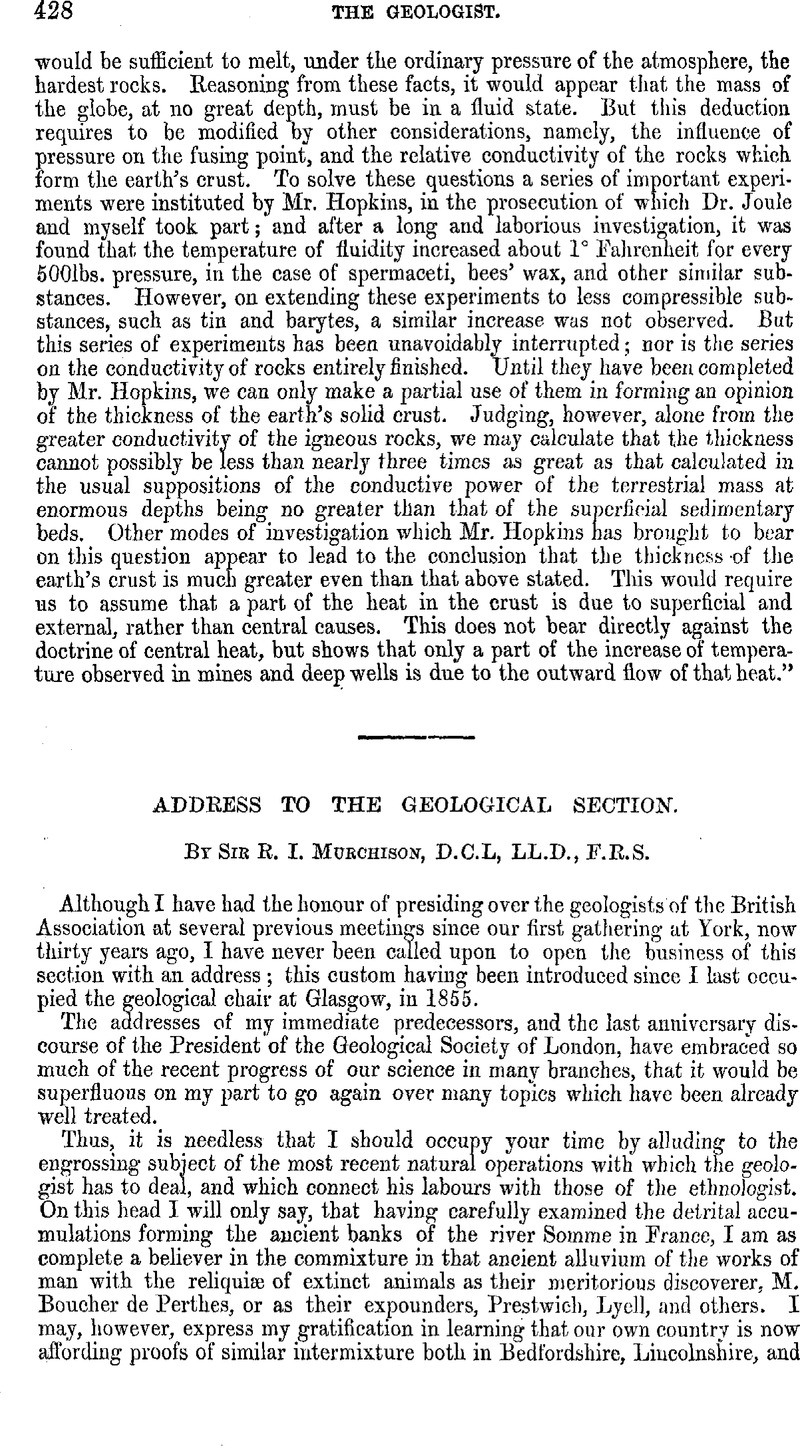No CrossRef data available.
Article contents
Address to the Geological Section
Published online by Cambridge University Press: 17 March 2016
Abstract

- Type
- Other
- Information
- Copyright
- Copyright © Cambridge University Press 1861
References
page 430 note * See Reports of British Association for 1855 (Glasgow Meeting). At that time I was not aware that the same order was developed on a grand scale in Canada, nor do I now know when that order was there first observed by Sir W. Logan. I then (1855) simply put forward the facts as exhibited on the north-west coast of Scotland; viz., the existence of what I termed a lower or “fundamental gneiss,” lying far beneath other gneissose and crystalline strata, containing remains which I even then suggested were of Lower Silurian age. Subsequently, in 1859, when accompanied by Professor Ramsay, I adopted at his suggestion, the word “Laurentian,” in comp ment to my friend, Sir William Logan, who had then worked out the order, and mapped it on a stupendous scale. I stated, however, at the same time, that, if a British synonym was to have been taken, I should have proposed the word “Lewisian,” from the large island of the Lewis, almost wholly composed of this gneiss.
page 431 note * I learn, however, that in Bohemia, Dr. Fritsch has recently discovered strata lying beneath the mass of the Primordial Zone of Barrande, and in rocks hitherto considered azoic the burrows of annelide animals similar to those of our own Longmynd.
page 431 note † In completing at his own cost a geological survey of Spain, in which he has been occupied for several years, and in the carrying out of which he has determined the width of the sedimentary rocks of the Peninsula (including the Primordial Silurian Zone, discovered by that zealous explorer, M. Casiano de Prado), M. de Verneuil has in the last few months chiefly examined the eastern part of the kingdom where few of the older palæozoic rocks exist. I am, however, informed by him, that Upper Silurian rocks with Cardiola interrupta, identical with those of France and Bohemia, occur along the southern flanks of the Pyrenees, and also re-occur in the Sierra Morena, in strata that over-lie the great mass of Lower Silurian rocks as formerly described by M. Casiano de Prado and himself. The southern face of the Pyrenees, he further informs me, is specially marked by the display of mural masses of Carboniferous strata, which, succeeding the Devonian rocks, are not arranged in basin shape, but stand out in vertical or highly inclined positions, and are followed by extensive conglomerates and marls of Triassic age, and these by deposits charged with fossils of the Lias.
page 431 note ‡ The Silurian classification was proposed by me in 1835, and in the following year, 1836, Dr. Emmons suggested that his black shale rocks, which he called Taconic, were older than any I described.
page 431 note § Nor are the writings of the Professors W. B. and H. D. Rogers in unison with the opinions of the authors here cited.
page 432 note * In the last edition of Siluria the distinction was drawn between the lower and upper Lingula-flags, but the fauna of the latter is now much enlarged.
page 433 note * See Russia and the Ural Mountains.
page 433 note † Monats-Bericht d. König. Akad. der Wiss. Berlin, 18 April, 1861.
page 434 note * This map is already on sale in Manchester.
page 434 note † “American Journal of Science,” May, 1861.
page 437 note * See Russia, in Europe and the Ural Mountains.
page 442 note * In another part of this Number we give the paper of Professor Owen, describing this interesting fossil as Plesiosaurus Australis.
page 442 note † It must, however, be noted that the collection sent to me consists of small specimens of rock forming an imperfect series.
page 443 note * Lord Francis Egerton, afterwards the Earl of Ellesmere.




